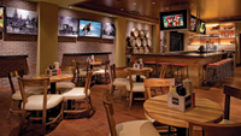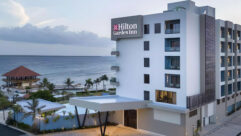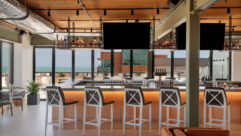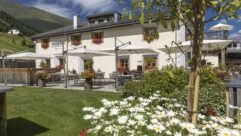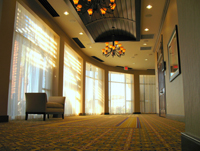

Hilton Phoenix Chandler Hotel, Chandler, Ariz.
Nov 24, 2009 12:00 PM
Getting in After Construction
When AV integration firm Sound Image was asked to design and build the AV systems for the Hilton Phoenix Chandler hotel in Chandler, Ariz., the hotel was already under construction with six floors built and the exterior nearly finished.
When Sound Image was approached to design and build an AV system for the Hilton Phoenix Chandler in Chandler, Ariz., the hotel was already under construction with six floors up and a nearly completed exterior.
The first challenge for Sales Engineer Eric Johnson and his Sound Image team was integrating their approach into a done-deal construction scheme without tearing up the basic plans and starting over.
“Our client, Gary Scarborough, was hired by Hilton International as the builder and this was his first full-service hotel, and because of the high-tech nature of the Chandler area, AV had to be beyond state-of-the-art,” Johnson says.
“With a budget of $150,000, we had to provide a sophisticated background music system with touchscreen control technology plus a digital signage system, all reflecting the level of technology in that city,” he says. “Chandler has been called the ‘Silicon Valley of the Desert’ with companies like Microchip, Intel, and Freescale, all leaders in the semiconductor industry. So the goal was to create a technology package so that when those types of clients came into the hotel, it would feel very familiar and cutting-edge to them.”
Johnson envisioned a smooth sound system that produced a good audible background level at low volumes so people could converse with someone right next to them without shouting, yet clearly hear the music in the background. A guest could walk anywhere and not be disturbed or distracted by any single loudspeaker running louder than it needed to be.
Johnson chose Martin Audio loudspeakers, which he was already familiar with and knew would produce the desired sound quality over a long lifespan. “The design called for high-quality sound at a low volume, and we could get rich low-frequency sound and clarity. The Martin ceiling speakers made sense for music and speech in a variety of settings from the lobby, to the meeting rooms and bar/restaurant. And the ease of installing Martin speakers was particularly appealing,” he says.
In addition to strategically deploying 125 Martin Audio C8.1T, C6.8T, and C4.8T ceiling loudspeakers throughout the facility, Sound Image put in a Crestron control system consisting of a TPMC-8X wireless touchpanel and wall-mount docking station with TPS-4L and TPS-6L touchpanels. Other system components included Crown CTS 600, 1200, and 2000 power amps, BSS London Blu processing, and Draper projection screens.
Johnson chose a full complement of enclosures from Middle Atlantic Products having had a long history of deploying the company’s products. “They have always been on time with their delivery and have a selection of products that is always being improved for use in the AV Industry,” he says.
Hilton Phoenix Chandler Hotel, Chandler, Ariz.
Nov 24, 2009 12:00 PM
Getting in After Construction

The Sound Image design called for strategically deploying 125 Martin Audio C8.1T, 6.8T, and C4.8T ceiling loudspeakers throughout the facility; a Crestron TPMC-8X wireless touchpanel and TPS-4LW and TPS-6L wall-mount touchpanels; Crown Audio CTS 600, 1200, and 2000 power amps; BSS London Blu processing; and Draper projection screens.
Complicating the issue was the AV team’s late start. “If the project had been put together before ground was broken, I’m sure it would have gone a lot more smoothly,” Johnson says.
Johnson led the team as sales liaison and design engineer working with Tim Smith on the original design team and Benjamin Davis as the original installer in the field.
The ceiling audio system flows through the hotel with ceiling loudspeakers in the restaurant with an attached bar that transitions fluidly into the lobby. “There is distributed audio in the porte-cochere, a vestibule which people walk through into the lobby, the restrooms off the lobby, an elevator lobby, a Starbucks location, and a corridor that leads to a pre-function area just outside the ballroom,” he says.
“The ballroom is a square room that divides into three sections: a half and two quarters. Because it has to divide and combine, the speakers were placed strategically in those three sections. When the ballroom is fully open, and depending where the chairs might get placed for an audience, we added a fourth speaker zone that fills in the gaps in the original speaker coverage.”
Related Links

This April, as a unique event in baseball history, a city’s two franchises both took up residence in new stadiums in the same season…

The Buzz: Installation Spotlight: Crisler Arena, Ann Arbor, Mich.
Time had come for a change—the 40-plus-year-old PA system at the Crisler Arena…

The new ASX floor-mounted active installation subwoofer that will be on display at Martin Audio’s demo room (W202C) during InfoComm 09 is fully capable of producing the highest SPL ever from a single low-frequency enclosure housing a single drive unit…
As part of 21 technical zones in the Sound Image design, the team also had to accommodate an exercise room, a large meeting room, a smaller boardroom, a pool bar, and the pool with high-quality audio and control. Each of those zones is addressed with its own amplifier channel so the team can shade the volume or EQ those spaces separately, or apply different processing to them.
Different spaces in the hotel provided different challenges, such as the lobby, which is dominated by hard surfaces including Travertine tile, granite countertops at the reception desk, a stone wall behind the desk, glass windows, and a 16 ft. ceiling. For that reason, Johnson chose to use the larger 8.1T loudspeakers. He placed six over the bar and 11 in the restaurant.
Johnson and the crew determined the loudspeakers’ positioning from a floor plan, focusing on areas where the public was likely to gather. “In addition, I opened up a space over the reception desk with the intent that when someone walked up to the desk, they wouldn’t have to fight to hear the person they were talking to,” he says.
“And the bar that has six speakers over it, and it is designed to flow right into the lobby. So we created a separate zone over the bar so the bartender could have independent volume control of that particular space so as it gets louder in the bar, he or she can adjust the volume accordingly and it doesn’t affect the people in the lobby.”
The ceiling loudspeakers in the meeting room also act as a reinforcement system with active mic inputs in the room to support a maximum of two microphones. There’s an auto mixer and DSP that manages those microphone inputs with line inputs to plug in laptops, iPods, or a DVD player.
A Crestron system controls the audio, and there are drop-down electric screens in the ballroom and meeting room. There are four touchpanels in the ballroom, one for each quarter and one at each bar (front bar and pool bar) and one each in the manager’s office, the meeting room, the boardroom, the fitness room, and the closet where a staff member can access the pre-function.
The installation took three weeks for the wiring and two and a half weeks of actual installation. “For us, the challenge was dealing with an existing structure and clearly delineated areas of responsibility for each trade with not a lot of communication between each of us,” Johnson says. “We were basically operating autonomously from every other contractor. Ultimately, the system is up and functional and working, so we were able to overcome the communications issues and get the job done, regardless.
“A personal disappointment under the heading ‘Best Laid Plans’ would be the placement of the speakers because the ceilings of the spaces we were putting speakers into were so densely populated with other systems such as HVAC, fire alarm, and control, etc.,” he says.
“But we knew we would have a lot of forgiveness if we had to move these speakers because the Martins have 180-degree and 90-degree coverage patterns. I was free to move them around in the field, within several feet in some cases. And we did very little in terms of output EQ because the speakers don’t really need it.”


